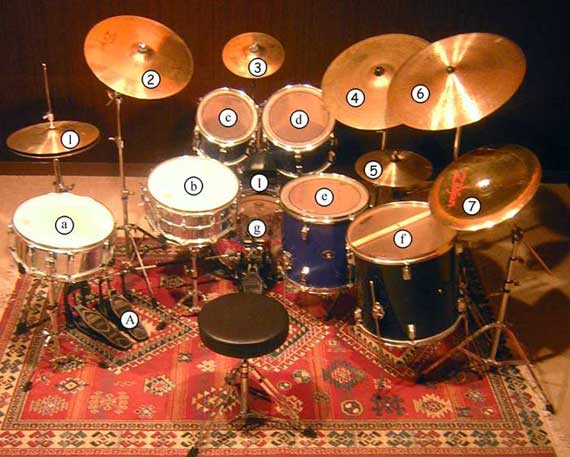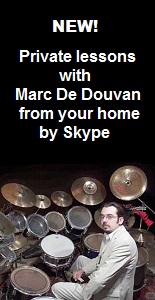
 : : : Lessons : : Conceiving your drum set : Set 6 : Fusion
: : : Lessons : : Conceiving your drum set : Set 6 : Fusion
Set 6 : Fusion
(7 drums, 9 cymbals, 1 cowbell, 1 double pedal)

- Description:
- 1: Hi-hat pedal 14''
- 2 : Crash 17''
- 3 : Splash 10'' or 12''
- 4 : Ride 20''
- 5: Suspended Hi-hat 12''
- 6 : Crash 19''
- 7: Chinese 16''
- a: "Piccolo" snare drum 14 or 13 x 5''
- b: Snare drum 14 x 6.5''
- c: Suspended high tom 10''
- d: Suspended medium tom 12''
- e: Piccolo floor tom 14''
- f: Floor tom 16''
- g: Bass Drum 20''
- I: Large cowbell
- A: Bass drum double pedal
A typical set of the 1980s, popularized by the great drummers of jazz-rock (fusion) and "studio sharks" of the era: Steve Gadd (but with a set of cymbals close to standard set 4 (but all 18'' nevertheless: a crash, a crash-ride and a “leopard” ride, it's enough rare and interesting to be noted)), Vinnie Colaiuta (Frank Zappa, Sting), Dave Weckl (Chick Corea, Michel Camilo, Madonna), these last two integrating sometimes three splashes into their set, Dave Weckl playing early with a 15" floor tom instead of the piccolo snare, he has also the idea to put the 6" splash upside down on the 12" separated by a felt washer, to save space, and a small 14" Chinese on a 18" crash to mix the two timbres and resonances (cymbals "stack") and plays sometimes with a pair of bongos and a djembe at the left of hi-hat, Dennis Chambers (John McLaughlin, George Clinton), sometimes, generally with the addition of a 13" suspended tom placed in place of the 12" here (the 12" being placed in place of 10" and 10" to the left) and a 18" floor tom at the right of the 16", and occasionally a suspended 20" "gong" bass drum above (the bass drum with pedal being 22" in diameter).
Some older but progressive jazz drummers have also adopted it at this time, as Elvin Jones (John Coltrane) but with only three 20'' crash-rides and no double pedal or piccolo snare, Tony Williams (Miles Davis, at his jazz-rock period) with the addition of a 18" floor tom but without piccolo snare either, nor suspended hi-hat nor double pedal nor Chinese, or Peter Erskine (Weather Report, John Abercrombie).
More recently we can name also, Marvin "Smitty" Smith and Oliver Gene Lake JR (both Steve Coleman's drummers), Virgil Donati (Frank Gambale, Derek Sherinian, Michel Polnareff) with a floor tom 14" instead of the "piccolo" snare and a second smaller snare ("sopranino" 10"x4") above (the other two floor toms on the right being 16 and 18"), two more crashes (18 and 16") to the left of the left hi-hat and with the positions of the ride cymbal and suspended hi-hat inverted and again another crash 18" above on the left and at last (sometimes only) a splash to the left above of the left hi-hat, a cable hi-hat on the right and two toms suspended very high above with vertical skin ("air" toms: 10" on the left and 13" on the right), Omar Hakim (Weather Report, Michel Petrucciani, Bobby McFerrin) often with a same set as Dennis Chambers, except 18 " tom and suspended bass drum, Robby Ameen and Horacio "El Negro" Hernandez (sometimes) for Latin Jazz, but with an additional cowbell stand on left foot, Bertrand Renaudin with the same set of drums as Omar Hakim except the bass drum of bebop type, "Jazzette" (18 ") and only one snare drum, and a set of unique cymbals, designed especially for him, all in " leopard " finish (without chiselling nor polishing, with sparse hand hammering) and a symmetrical arrangement to encourage a playing totally ambidextrous of the hands (from left to right: Chinese 18 ", ride 20", crash 16 "(above) to the left, and the reverse in mirror on the right: crash 16 ", ride 22" (for a lower fundamental tone), Chinese 20 ", the hi-hat being below and to the right of the first Chinese and left of the first ride, and the rides on each side of suspended toms, above, overlapping).
Note the addition of a Chinese cymbal, an additional snare drum (more dry, to the left of left foot, for fast tempo, to change the ergonomics (uncrossed arms hi-hat playing), or to put surprising accents), of the bass drum double pedal (invented in 1980s) and a suspended hi-hat with wing nut closing to the right (invention of the 1990s, to release the left foot otherwise used to play with the stick on the closed hi-hat, which is typical of the rock style).
The splash is bigger to get closer to crashes and one of the crashes is bigger to get closer to the ride. This gives a very versatile set with a large tonal range, variety of timbres, playability, while being very "bound", on the sound aspect and condensed, spatially. One of the first set of true virtuoso of drum set, with continuous change of playing style, which the premises can be seen in the set of Louie Bellson, the first drummer in history to use two bass drums with the feet.
Furthermore, most drummers mentioned here have had the honor to play at the tribute concerts to Buddy Rich, which is a kind of consecration given by his peers.
Now, to describe this set more in details, note the position of the ride in height, to favor the playing with the suspended hi-hat and toms descent (with 4 toms almost touching themselves this time), notably with 3 limbs rolls (hands and right foot) with a different drum per limb (typical of the way of playing of the drummers mentioned before).
Note the shift of the set to the right, which is compensated by traditional grip used by the drummers mentioned (see set 2 for explanation about "traditional grip").
The following sets provide little invention compared with this one, except a wider tonal range, which allows a more melodic playing, which Terry Bozzio is one of the masters (which explains its plethoric set), except the Latin set, which includes Latin instruments, exactly.
Finally, note that adding more instruments will now make almost impossible fast passages between the two ends of the set. There is therefore a matter of choice of playing and not technical progress in the absolute, about drum sets, it is important to emphasize that (if not, all drumset virtuosos would have the same set at a given time, which is absolutely not the case at all, I hope I have demonstrated it by quoting different great drummers from various eras).
Marc De Douvan, march 2006, augmentation and translation in English: march 2015.
© 2005 Marc de Douvan Crédits Mentions légales
